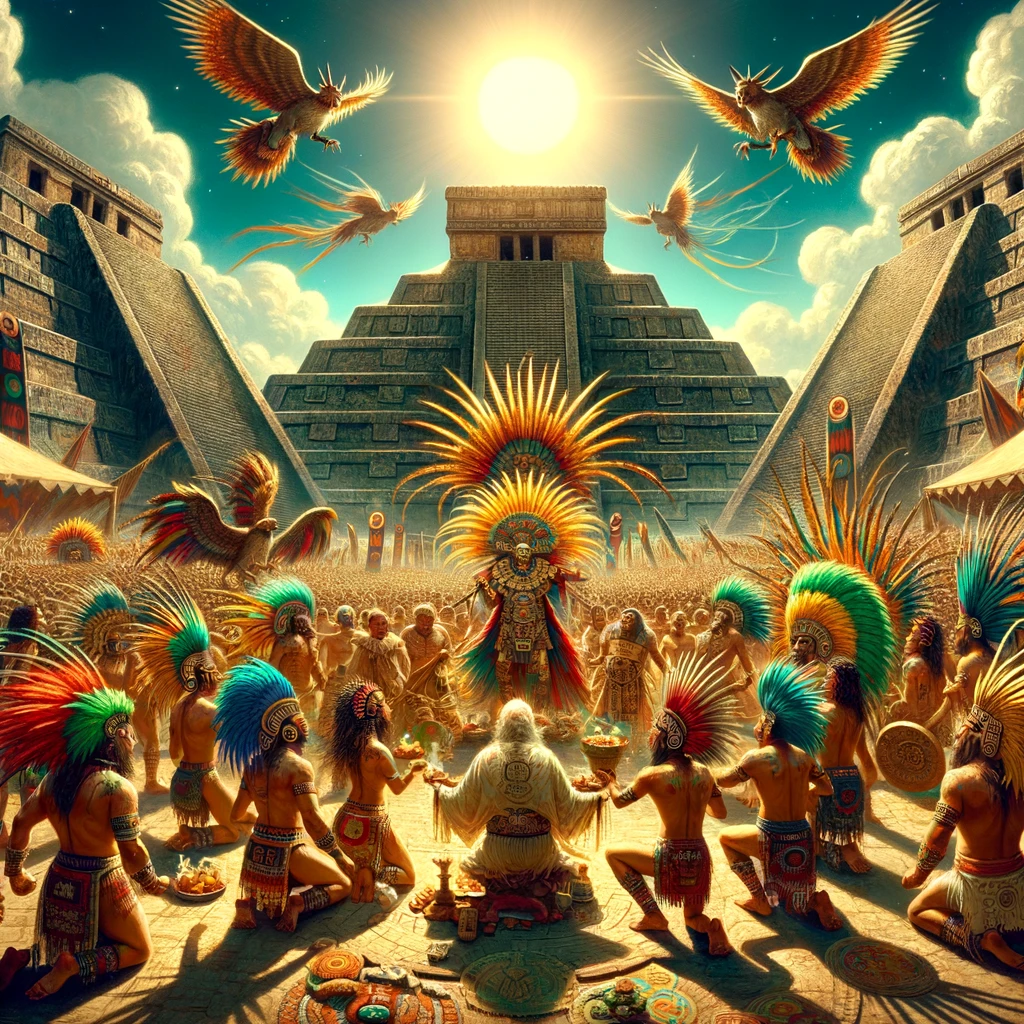
The Aztec civilization, renowned for its rich cultural tapestry and intricate religious ceremonies, observed numerous festivals throughout the year. Among these, Panquetzaliztli stands out as a significant celebration, marking the beginning of the solar year and honoring Huitzilopochtli, the revered god of the sun and war.
Origins and Significance
Panquetzaliztli, pronounced as "pan-ket-zah-LEES-tlee," was one of the 18 monthly festivals in the Aztec calendar, each dedicated to various gods and deities. It fell around the end of November and the beginning of December, coinciding with the end of the rainy season in the Mesoamerican region.
The festival held profound significance for the Aztecs as it symbolized the renewal of life, the triumph of light over darkness, and the cycle of agricultural fertility. At its core, Panquetzaliztli celebrated the mythological journey of Huitzilopochtli, who was believed to be reborn annually, ensuring the continuation of the world and its inhabitants.
Rituals and Celebrations
Panquetzaliztli was a vibrant and elaborate affair, marked by a series of rituals, ceremonies, and festivities. The celebrations typically lasted for several days and involved the entire Aztec community, from rulers and priests to commoners.
One of the central rituals of Panquetzaliztli was the reenactment of Huitzilopochtli's mythical battles against darkness and chaos. Participants adorned themselves in elaborate costumes, mimicking warriors, and engaged in mock combat, symbolizing the god's triumph over adversity.
Another key aspect of the festival was the offering of sacrifices to Huitzilopochtli. Captives or prisoners of war were often chosen as sacrificial victims, their hearts ritually extracted as an offering to the sun god. These sacrifices were believed to ensure the continued favor and protection of Huitzilopochtli and the maintenance of cosmic order.
In addition to religious ceremonies, Panquetzaliztli featured various forms of entertainment and revelry. Music, dance, and theatrical performances filled the streets, providing entertainment for the gathered crowds. Markets bustled with activity as vendors sold food, crafts, and ceremonial items, adding to the festive atmosphere.
Legacy and Modern Interpretations
While the Aztec civilization ceased to exist centuries ago, the legacy of Panquetzaliztli and other cultural traditions continues to resonate in modern-day Mexico and beyond. Today, descendants of the Aztec people, as well as scholars and enthusiasts of Mesoamerican culture, strive to preserve and revive these ancient customs.
In recent years, efforts to reclaim and reinterpret Panquetzaliztli have gained momentum, with communities organizing festivals and events to honor Huitzilopochtli and celebrate Aztec heritage. These modern interpretations often emphasize cultural pride, artistic expression, and community engagement, serving as a testament to the enduring legacy of the Aztec civilization.
In conclusion, Panquetzaliztli stands as a testament to the rich and complex tapestry of Aztec culture and religion. As a festival honoring Huitzilopochtli, the sun and war god, it served as a reminder of the cyclical nature of life, the eternal struggle between light and darkness, and the interconnectedness of the human experience with the cosmos. Though the Aztec civilization may have faded into history, the spirit of Panquetzaliztli lives on, inspiring awe and fascination in those who seek to understand and appreciate the wonders of Mesoamerican heritage.
Origins and Significance
Panquetzaliztli, pronounced as "pan-ket-zah-LEES-tlee," was one of the 18 monthly festivals in the Aztec calendar, each dedicated to various gods and deities. It fell around the end of November and the beginning of December, coinciding with the end of the rainy season in the Mesoamerican region.
The festival held profound significance for the Aztecs as it symbolized the renewal of life, the triumph of light over darkness, and the cycle of agricultural fertility. At its core, Panquetzaliztli celebrated the mythological journey of Huitzilopochtli, who was believed to be reborn annually, ensuring the continuation of the world and its inhabitants.
Rituals and Celebrations
Panquetzaliztli was a vibrant and elaborate affair, marked by a series of rituals, ceremonies, and festivities. The celebrations typically lasted for several days and involved the entire Aztec community, from rulers and priests to commoners.
One of the central rituals of Panquetzaliztli was the reenactment of Huitzilopochtli's mythical battles against darkness and chaos. Participants adorned themselves in elaborate costumes, mimicking warriors, and engaged in mock combat, symbolizing the god's triumph over adversity.
Another key aspect of the festival was the offering of sacrifices to Huitzilopochtli. Captives or prisoners of war were often chosen as sacrificial victims, their hearts ritually extracted as an offering to the sun god. These sacrifices were believed to ensure the continued favor and protection of Huitzilopochtli and the maintenance of cosmic order.
In addition to religious ceremonies, Panquetzaliztli featured various forms of entertainment and revelry. Music, dance, and theatrical performances filled the streets, providing entertainment for the gathered crowds. Markets bustled with activity as vendors sold food, crafts, and ceremonial items, adding to the festive atmosphere.
Legacy and Modern Interpretations
While the Aztec civilization ceased to exist centuries ago, the legacy of Panquetzaliztli and other cultural traditions continues to resonate in modern-day Mexico and beyond. Today, descendants of the Aztec people, as well as scholars and enthusiasts of Mesoamerican culture, strive to preserve and revive these ancient customs.
In recent years, efforts to reclaim and reinterpret Panquetzaliztli have gained momentum, with communities organizing festivals and events to honor Huitzilopochtli and celebrate Aztec heritage. These modern interpretations often emphasize cultural pride, artistic expression, and community engagement, serving as a testament to the enduring legacy of the Aztec civilization.
In conclusion, Panquetzaliztli stands as a testament to the rich and complex tapestry of Aztec culture and religion. As a festival honoring Huitzilopochtli, the sun and war god, it served as a reminder of the cyclical nature of life, the eternal struggle between light and darkness, and the interconnectedness of the human experience with the cosmos. Though the Aztec civilization may have faded into history, the spirit of Panquetzaliztli lives on, inspiring awe and fascination in those who seek to understand and appreciate the wonders of Mesoamerican heritage.